Connecticut is home to many birds, including several species of red birds. These birds are beautiful in the summertime as they flit from tree to tree, singing and standing out against the lush green foliage.
Redbirds can be found in many habitats, from backyards and parks to woodlands and wetlands. These birds often form large flocks and play an essential role in Connecticut’s ecosystems.
Whether you want to observe them up close or enjoy the sound of their songs, there are many opportunities to appreciate red birds in Connecticut.
24 Red Birds In Connecticut
Connecticut, often celebrated for its picturesque landscapes and serene vistas, has captivated the hearts of many with its natural charm.
Among the diverse array of wildlife inhabiting this northeastern state, a phenomenon continues to intrigue both seasoned birdwatchers and curious onlookers alike.
Here are 24 Red Birds In Connecticut.
1. House Finch
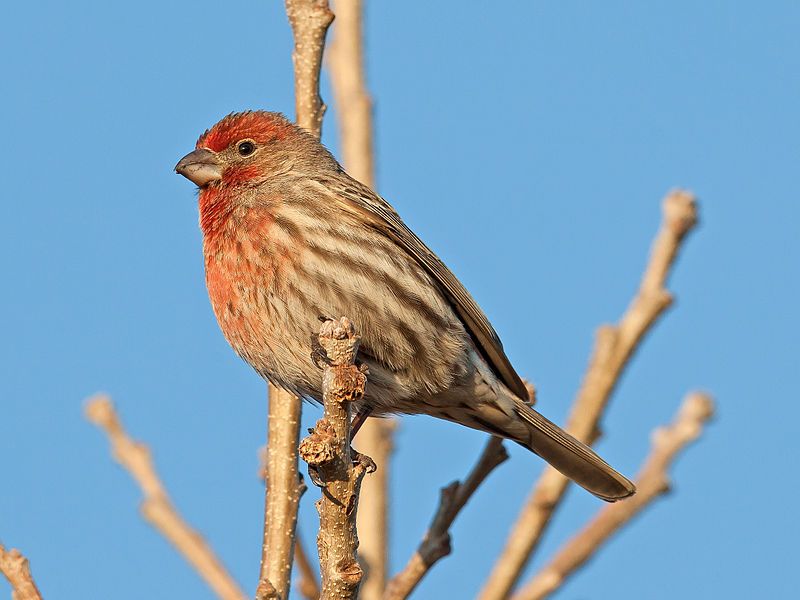
The house finch is a bird species belonging to the family Fringillidae, including other finch species. It is native to western North America but has been introduced to the eastern half of the continent and Hawaii.
This species is part of the genus Haemorhous, which comprises three species of American rosefinches. The house finch is a small bird often found in urban and suburban areas. It has a relatively short, conical bill and a distinctive red or yellow head and breast.
It feeds on seeds, grains, and insects and visits bird feeders in search of food. The house finch is a vocal species known for its song, a series of short notes.
The house finch is a common species that typically occurs in small flocks and can be seen in yards and gardens.
| Kingdom | Animalia |
| Phylum | Chordata |
| Class | Aves |
| Order | Passeriformes |
| Family | Fringillidae |
| Genus | Haemorhous |
| Species | H. mexicanus |
2. Northern Cardinal
The northern cardinal is a North American bird species easily recognized by its bright red plumage. It is commonly called the redbird, common cardinal, red cardinal, or simply cardinal.
It is a member of the genus Cardinalis, which includes several species of birds. The northern cardinal is a relatively large songbird, with a length of 21–23 cm and a 25–31 cm wingspan. It has a distinctive crest on the head and a mask-like pattern on the face.
Its bill is short and thick, and its legs are short. The northern cardinal is mainly found in woodlands and thickets but can also be seen in suburban and urban areas.
The males are usually more brightly colored than the females, with bright red plumage, a black face mask, and a grayish-brown crest. The females are duller in color, with yellowish-brown plumage, and lack the black face mask. The northern cardinal is the state bird of seven U.S.
States and the provincial bird of two Canadian provinces. They are a popular bird in the United States and are considered beautiful and essential to the local ecosystem.
| Kingdom | Animalia |
| Phylum | Chordata |
| Class | Aves |
| Order | Passeriformes |
| Family | Cardinalidae |
| Genus | Cardinalis |
| Species | C. cardinalis |
3. Scarlet Tanager
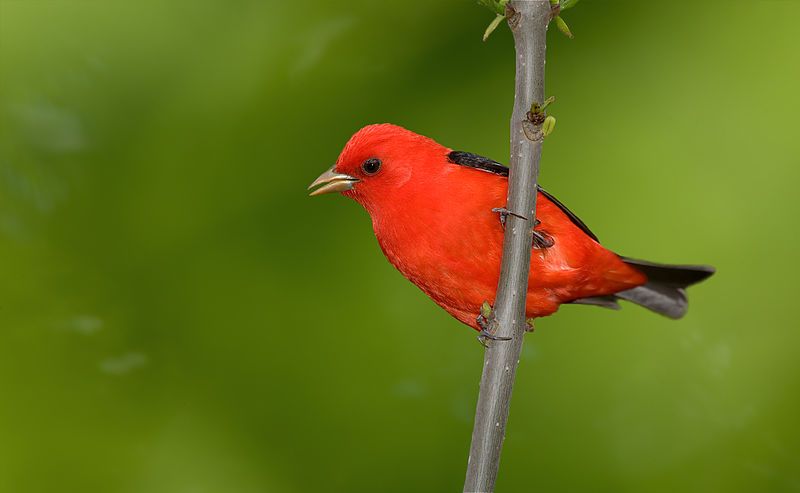
The scarlet tanager is a medium-sized American songbird. It is an iconic bird throughout the United States and parts of Canada. It is named for its bright red plumage, black wings and tail.
Until recently, it was believed to belong to the tanager family. However, more recent research has found that it and other members of its genus belong to the cardinal family. This means that it is more closely related to cardinals than to tanagers.
The scarlet tanager has seen a decline in population in recent years due to habitat loss, but conservation efforts are underway to help protect the species.
| Kingdom | Animalia |
| Phylum | Chordata |
| Class | Aves |
| Order | Passeriformes |
| Family | Cardinalidae |
| Genus | Piranga |
| Species | P. olivacea |
4. Summer Tanager
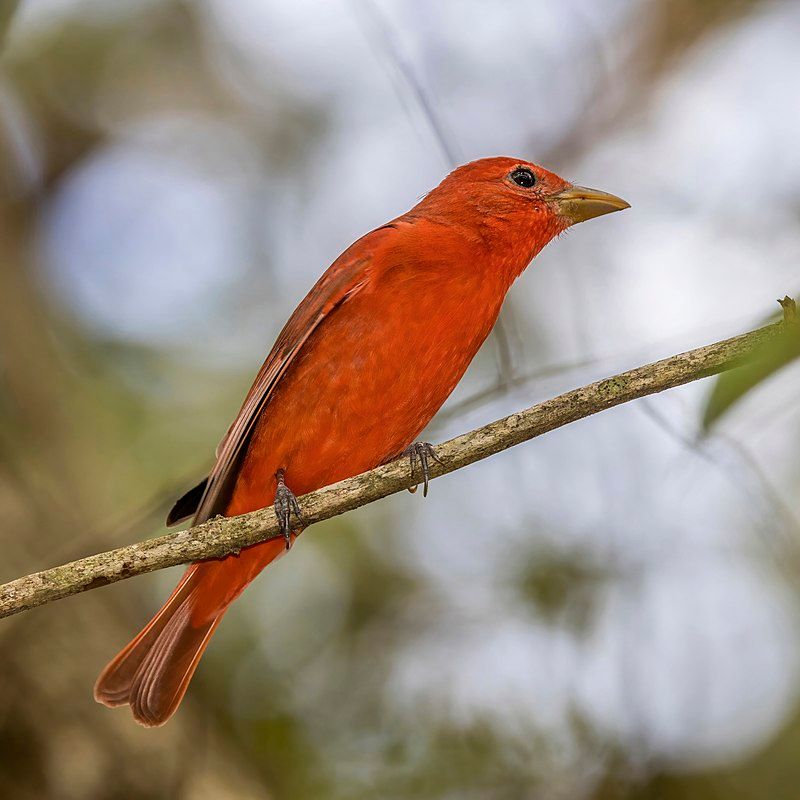
The summer tanager is a medium-sized songbird native to North and South America. It used to be classified as part of the tanager family, but it and other members of its genus are now considered part of the cardinal family.
This is due to the similarities between the summer tanager’s plumage and vocalizations and those of the cardinal family. The plumage of the summer tanager is typically a bright yellow or orange, with a black head and wings.
Its song is a melodic chirp that is distinct from other species. The summer tanager is a famous bird to watch in its natural environment, as it is colorful and musical.
| Kingdom | Animalia |
| Phylum | Chordata |
| Class | Aves |
| Order | Passeriformes |
| Family | Cardinalidae |
| Genus | Piranga |
| Species | P. rubra |
5. Two-Barred Crossbill
The two-barred crossbill, also known as the white-winged crossbill, is a bird species in the finch family Fringillidae. This small passerine bird is typically found in coniferous forests across North America and the Palearctic.
This bird is recognized by its distinctive two-barred pattern on its wings and tail.
It is a small bird, measuring around 8 to 10 inches long, and is usually reddish-brown. The two-barred crossbill is a very adaptable bird and can survive in various habitats, from wooded areas to coniferous forests.
It tends to feed mainly on the seeds of coniferous trees, including pine, spruce, and fir. Its diet also includes some insects, berries, and other small invertebrates. The two-barred crossbill breeds in the summer and typically lays two to four eggs in a nest.
The female incubates the eggs for about two weeks before they hatch. Both parents help feed the chicks, which faints after about three weeks. The two-barred crossbill is an important species, as it helps to disperse seeds and maintain healthy forests.
Its presence also helps to support other species of wildlife in its habitat. Unfortunately, this bird is threatened by habitat loss, with its population declining in some areas.
It is classified as a species of “Least Concern” by the IUCN, but conservation efforts are still needed to ensure its long-term survival.
| Kingdom | Animalia |
| Phylum | Chordata |
| Class | Aves |
| Order | Passeriformes |
| Family | Fringillidae |
| Genus | Loxia |
| Species | L. leucoptera |
6. Red Crossbill
The red crossbill is a small passerine bird that belongs to the finch family Fringillidae. It is also called the common crossbill and is easily identifiable due to its crossed mandibles.
This feature of the bird’s beak helps it extract seeds from conifer cones and other fruits, allowing it to feed on various foods. Crossbills have evolved to be able to do this, as their beaks are designed to be able to open up cones and access the seeds inside.
The tips of their mandibles are slightly curved, enabling them to pick up the seeds with relative ease.
Furthermore, the red crossbill has a firm grip, which allows it to hold onto the cones and break them open to access the seeds. The red crossbill is a very resourceful bird and can feed on various seeds and fruits.
It is also a very social bird, often gathering in large flocks to feed together. This behavior helps them to find plenty of food sources, as they can cover more ground when searching for food.
Additionally, the red crossbill is an integral part of the ecosystem, helping to spread seeds to other areas where they may not have been before. Overall, the red crossbill is an exciting and unique bird that has evolved to be able to feed on a variety of different seeds and fruits.
Its distinctive crossed mandibles enable it to extract seeds from conifer cones and other fruits, giving it a competitive edge over other species. Furthermore, this bird plays a vital role in the ecosystem, helping to spread seeds to other areas.
| Kingdom | Animalia |
| Phylum | Chordata |
| Class | Aves |
| Order | Passeriformes |
| Family | Fringillidae |
| Genus | Loxia |
| Species | L. curvirostra |
7. Painted Bunting
The painted bunting is a species of bird in the family Cardinalidae, which is native to North America. It is a brightly colored bird, with males having more colorful plumage than females.
The male painted bunting’s bright plumage does not appear until its second year of life; in its first year, it can only be distinguished from the female by close inspection. Generally, the males have a bright red head, green back, and blue rump.
On the other hand, the female is duller in color, with an olive-green head and grayish-brown wings and back. The painted bunting is a small bird, typically measuring about 5 inches long. They are found in wooded areas, meadows, and gardens near water.
They primarily feed on insects, seeds, and fruits. They nest in shrubs or low trees and lay a clutch of 3-5 eggs. The female will incubate the eggs for 11-13 days, and the chicks will fledge in 10-16 days.
The painted bunting is an essential species in North America, playing a vital role in the ecosystem. They provide food for predators, such as hawks, owls, and cats. They also help to control insect populations, as their diet often consists of insects.
In addition, they are essential pollinators, helping to spread pollen from flower to flower.
| Kingdom | Animalia |
| Phylum | Chordata |
| Class | Aves |
| Order | Passeriformes |
| Family | Cardinalidae |
| Genus | Passerina |
| Species | P. ciris |
8. Common Redpoll
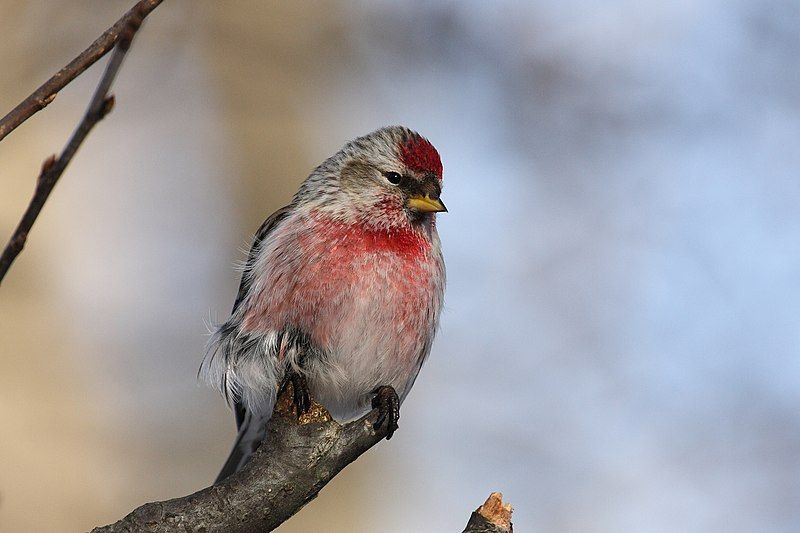
The common redpoll is a small bird belonging to the finch family. It is distinguishable from other finches by its distinctive reddish-brown head and chest and its yellowish-white belly.
The common redpoll is found in various habitats, including shrublands, woodlands, and tundra areas. It breeds primarily in northern regions, and its range extends further south than the Arctic redpoll.
Its habitat usually includes some form of thicket or shrubbery, which it uses for nesting and foraging. Common redpolls feed primarily on seeds and other plant materials, such as buds and berries. They will also occasionally eat small insects.
The birds form flocks in the summer and migrate to more northern breeding grounds. During the winter, they are more likely to be found in small groups in their southern range.
| Kingdom | Animalia |
| Phylum | Chordata |
| Class | Aves |
| Order | Passeriformes |
| Family | Fringillidae |
| Genus | Acanthis |
| Species | A. flammea |
9. Red-Bellied Woodpecker
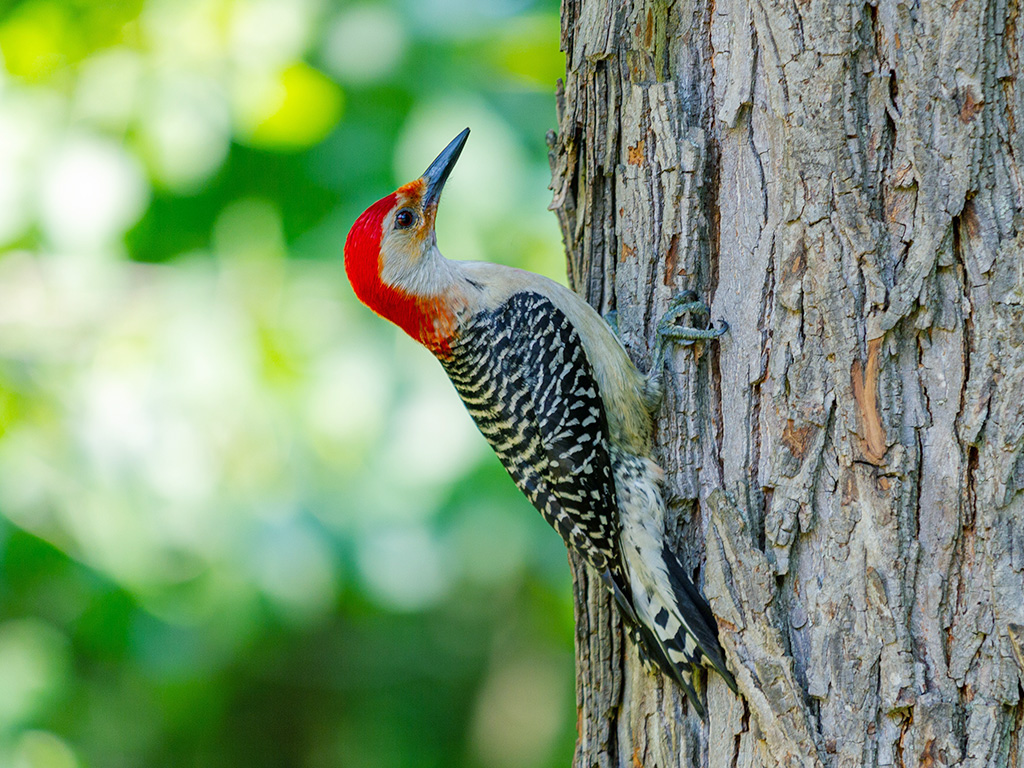
The red-bellied woodpecker is a species of woodpecker found in the family Picidae. It can primarily be found in the eastern United States, stretching from Florida in the south to Canada in the north.
This woodpecker species is considered medium-sized, with lengths ranging from 8-10 inches and weighing approximately 1.5-3.2 ounces. It can be identified by its bright red head and belly, with a contrasting black and white back.
The red-bellied woodpecker is an omnivorous species, feeding on various insects, nuts, and fruit. It is also known to forage on tree bark for ants and other invertebrates.
During the breeding season, it can be found in mature deciduous or mixed forests and in suburban areas. It is known to excavate nesting cavities in tree trunks, making it a valuable species for conserving these habitats.
In addition to its essential role in maintaining wooded ecosystems, the red-bellied woodpecker is also a popular species among birdwatchers. Its bright colors and distinctive call make it a favorite in many areas, often seen in backyards and parks.
This species also benefits humans as it helps control insect populations, making it a valuable asset to any landscape.
| Kingdom | Animalia |
| Phylum | Chordata |
| Class | Aves |
| Order | Piciformes |
| Family | Picidae |
| Genus | Melanerpes |
| Species | M. carolinus |
10. Red-Headed Woodpecker
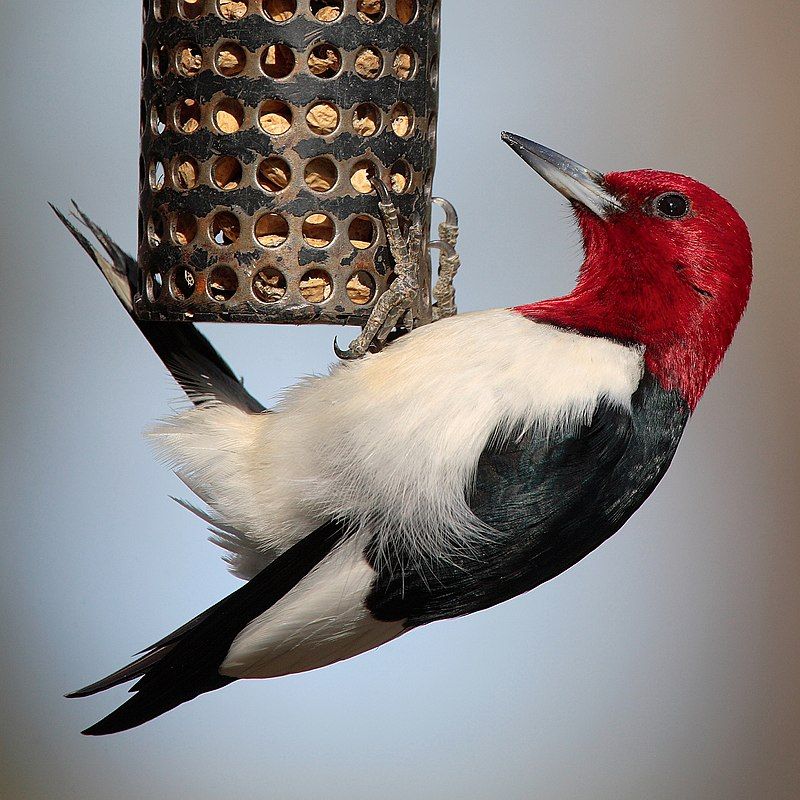
The red-headed woodpecker is a distinctive bird native to temperate North America. It is a mid-sized woodpecker, measuring approximately 7-9 inches long and possessing a bright red head, white neck, and white belly.
Its wings are black with white bars, and its back is grayish-brown. This bird can be found across southern Canada and the east-central United States, where it favors open country habitats like grasslands, savannas, and woodlands.
It is most commonly seen perched on trees or flying between trees, searching for food. Its diet consists mainly of insects and seeds but will also eat fruits, nuts, and berries.
The red-headed woodpecker is an essential species for its role in controlling insect populations and is also a famous bird among birdwatchers.
| Kingdom | Animalia |
| Phylum | Chordata |
| Class | Aves |
| Order | Piciformes |
| Family | Picidae |
| Genus | Melanerpes |
| Species | M. erythrocephalus |
11. Rose-Breasted Grosbeak
The rose-breasted grosbeak, commonly called the “cut-throat” due to its distinctive coloration, is a large and impressive songbird of the cardinal family. This species feeds primarily by foraging on the ground, searching for seeds and other small items among the foliage.
Males of this species are striking, with a black head, wings, back, and tail contrasting sharply with a bright rose-colored patch on their white chest. This eye-catching color combination has earned the rose-breasted grosbeak its colorful nickname.
| Kingdom | Animalia |
| Phylum | Chordata |
| Class | Aves |
| Order | Passeriformes |
| Family | Cardinalidae |
| Genus | Pheucticus |
| Species | P. ludovicianus |
12. Woodpeckers
Picidae is a family of birds found in almost every part of the world except for Australia, New Guinea, New Zealand, Madagascar, and the extreme polar regions.
This family comprises four birds: woodpeckers, piculets, wrynecks, and sapsuckers.
These birds have distinctive characteristics that make them unique and easily identifiable. Woodpeckers are perhaps the most well-known members of the Picidae family.
Their most prominent feature is their strong beaks, which they peck into trees and other hard surfaces. Woodpeckers also have stiff tails as a brace while pecking away.
They are usually brightly colored and have a unique call that can be heard from far away. Piculets are much smaller than woodpeckers and have thin, pointed beaks. They use their beaks to forage for insects in trees and other places.
They are usually dull-colored and can be pretty shy. Wrynecks are also similar in size to piculets but have a more slender body and a unique curved bill. They feed mainly on ants, and their calls are high-pitched and can be heard from far away.
Sapsuckers are the most prominent members of the Picidae family. They use a large, powerful beak to drill holes in trees and feed on the sap that oozes out. They are easily identifiable by their bright colors and unique call.
Overall, the Picidae family is an incredibly diverse group of birds, and each of the four species has unique characteristics and behaviors.
They can be found in almost every part of the world except for Australia, New Guinea, New Zealand, Madagascar, and the extreme polar regions.
| Kingdom | Animalia |
| Phylum | Chordata |
| Class | Aves |
| Order | Piciformes |
| Family | Picidae |
13. Northern Flicker
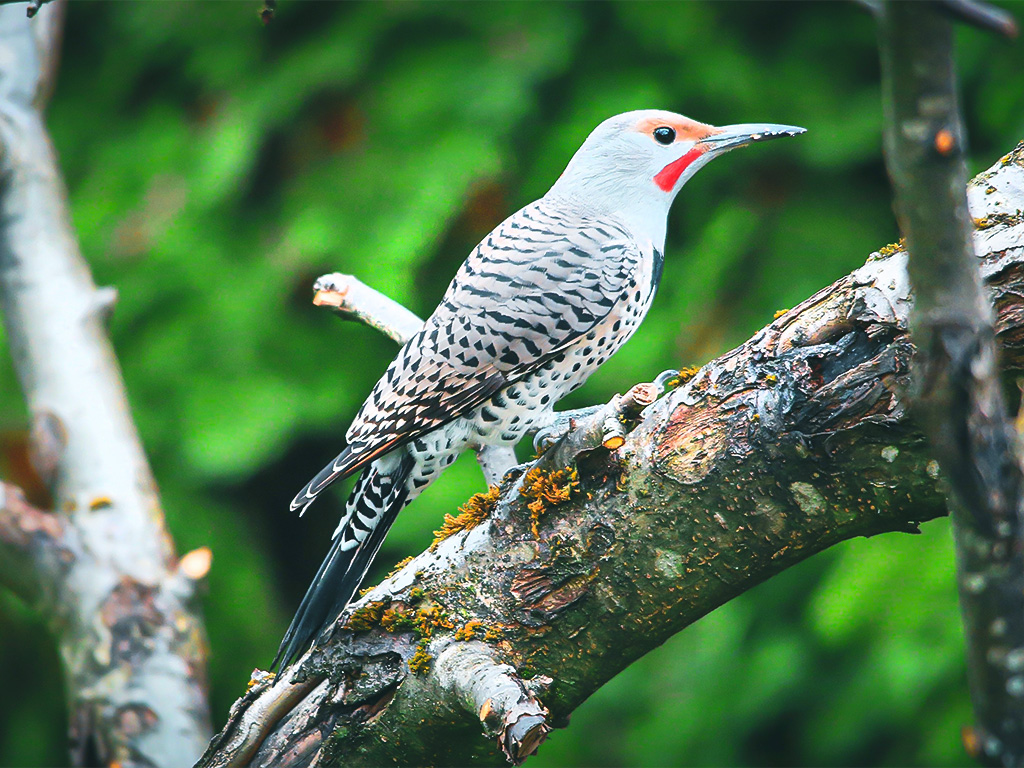
The northern flicker, also known as the familiar flicker, is a bird from the woodpecker family. It can be found in various habitats, ranging from woodlands to open fields, across much of North America, Central America, Cuba, and the Cayman Islands.
It is a medium-sized bird, with a length ranging from 28-34 cm and a wingspan of 41-44 cm. The northern flicker is easily identified thanks to its striking plumage. The upperparts are a warm brown, while the underparts are white with black barring.
The wings are black with a white patch near the tips, and the tail is black with white outer feathers. The head is adorned with a red or black patch, depending on the bird’s sex.
The northern flicker’s diet mainly consists of ants, beetles, and other insects, which it finds by digging into the ground with its strong beak. It is also known to eat fruit, berries, and seeds.
The northern flicker is one of the few species of woodpecker that migrate, typically traveling south in the winter and returning north in the spring.
| Kingdom | Animalia |
| Phylum | Chordata |
| Class | Aves |
| Order | Piciformes |
| Family | Picidae |
| Genus | Colaptes |
| Species | C. auratus |
14. Ruby-Throated Hummingbird
The ruby-throated hummingbird is a species of hummingbird that is found throughout Eastern North America. This species migrates to Central America, Mexico, and Florida during the winter months.
When summer arrives, the hummingbirds travel north to Canada and other parts of Eastern North America to breed. This hummingbird species is known for its long-distance migrations and is often seen flitting around flower beds and gardens in the summer.
It is important to note that the ruby-throated hummingbird is a migratory species and will not stay in one place for long.
To ensure the continued protection of these birds, it is essential to provide them with suitable habitat and to minimize any disruption to their migratory patterns.
| Kingdom | Animalia |
| Phylum | Chordata |
| Class | Aves |
| Clade | Strisores |
| Order | Apodiformes |
| Family | Trochilidae |
| Genus | Archilochus |
| Species | A. colubris |
15. Pileated Woodpecker
The pileated woodpecker is a species of woodpecker native to North America. It is the largest woodpecker on the continent and has a primarily black body with white stripes running down its neck and wings.
It is an insectivore, meaning it feeds mainly on insects, which it finds with its strong beak by breaking into dead or decaying wood. The pileated woodpecker is primarily found in deciduous forests in eastern North America, the Great Lakes, and the boreal forests of Canada.
It also inhabits some parts of the Pacific Coast. Unlike other woodpecker species, the pileated woodpecker prefers larger, mature trees, as they provide more food sources. It is often seen drilling rectangular holes into trees and logs for insect prey.
The pileated woodpecker is an integral part of North American ecosystems. It helps keep insect populations in check, disperses seeds, and helps aerate the soil. It is also seen as a symbol of wilderness and is a famous bird for birdwatchers.
| Kingdom | Animalia |
| Phylum | Chordata |
| Class | Aves |
| Order | Piciformes |
| Family | Picidae |
| Genus | Dryocopus |
| Species | D. pileatus |
16. Barn Swallow
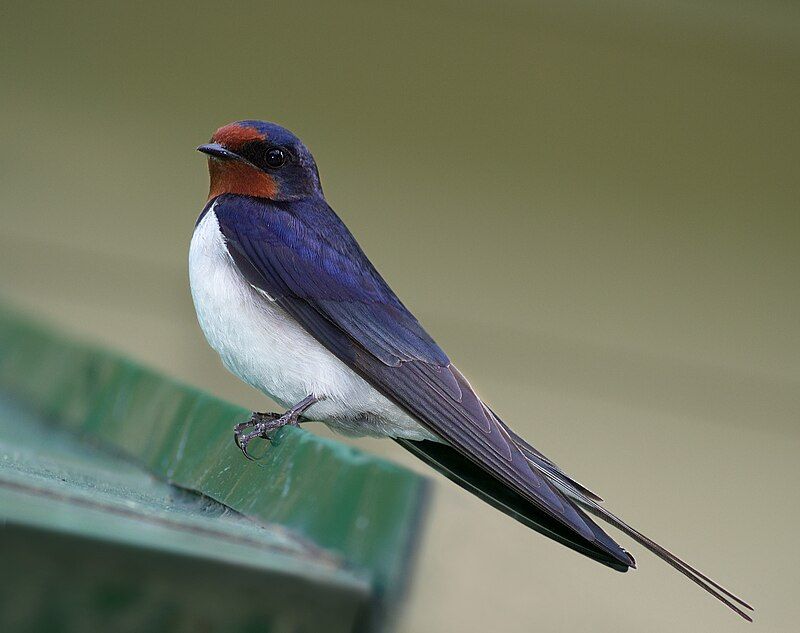
The barn swallow is a prevalent species of swallow. It is found worldwide, having a range that covers an incredible 251 million square kilometers. This makes it one of the most widespread passerines, or perching birds, in the world.
The barn swallow is also easily identifiable due to its striking blue upperparts and long, forked tail. This tail is particularly distinctive and is often a way of differentiating this species from other similar birds.
The barn swallow is a remarkable species, and its impressive range makes it a genuinely iconic bird.
| Kingdom | Animalia |
| Phylum | Chordata |
| Class | Aves |
| Order | Passeriformes |
| Family | Hirundinidae |
| Genus | Hirundo |
| Species | H. rustica |
17. Flickers
Colaptes is a genus of birds in the Picidae family, which includes woodpeckers. These birds can be found throughout the Americas.
Generally, Colaptes woodpeckers have brown or green backs and wings with black barring and a beige to yellowish underside with black spotting or barring. These birds’ heads often have colorful markings, which help distinguish them from other species.
They are considered medium-sized woodpeckers with a wingspan of around 20 inches. They are known for their loud, repetitive calls and habit of drumming on trees with their beaks. They are also known for their acrobatic aerial displays.
Colaptes woodpeckers feed on insects and larvae, which they extract from the bark of trees, and also feed on fruits, nuts, and berries. They nest in cavities in trees and habitually store food for later use.
| Kingdom | Animalia |
| Phylum | Chordata |
| Class | Aves |
| Order | Piciformes |
| Family | Picidae |
| Genus | Colaptes |
18. Red-Winged Blackbird
The red-winged blackbird is a medium-sized bird in a large part of the Western Hemisphere. It is a type of passerine bird, a classification of perching birds with feet with three toes facing forward and one toe facing backward.
This species of bird belongs to the family Icteridae, a group of songbirds characterized by their rich, musical vocalizations. They are known for their distinct red-and-yellow wing patches, making them popular among birdwatchers.
The red-winged blackbird is found mainly in North America, from Alaska and Canada to Mexico. It can also be found in various parts of Central America. They prefer open, grassy habitats like wetlands, marshes, meadows, and pastures.
Some populations live in more urbanized areas like parks and golf courses. The red-winged blackbird is an omnivore, meaning they feed on plants and animals. Their diet primarily consists of seeds, insects, and other invertebrates.
They will also consume fruit, frogs, small fish, and even rodents. They are known to be aggressive when protecting their nests and territories from intruders, often chasing away larger birds such as hawks, crows, and ravens.
The red-winged blackbird is an important species to many ecosystems. It is a keystone species that plays a critical role in the environment by providing food for other animals. It also controls insect populations and helps disperse seeds, allowing new plants to grow.
| Kingdom | Animalia |
| Phylum | Chordata |
| Class | Aves |
| Order | Passeriformes |
| Family | Icteridae |
| Genus | Agelaius |
| Species | A. phoeniceus |
19. Broad-Billed Hummingbird
The broad-billed hummingbird is a small-sized species found in Mexico and the southwestern United States. This species of bird displays sexual dimorphism, which means that males and females have physical differences.
In this species, the juveniles look more like female adults than males. The broad-billed hummingbird is a brightly colored bird with a bright red beak that is broad in shape. Its feathers are mainly green, and its underparts are pale yellow.
The tail is long, slender, and deeply forked. Its wings are long and pointed, and the primary flight feathers are black with white tips. The adult male also has an iridescent gorget or throat patch that is bright blue.
The broad-billed hummingbird is a fascinating species of bird that is a pleasure to observe in its natural environment. Its bright colours and unique bill make it a distinctive species that can be easily spotted.
| Kingdom | Animalia |
| Phylum | Chordata |
| Class | Aves |
| Clade | Strisores |
| Order | Apodiformes |
| Family | Trochilidae |
| Genus | Cynanthus |
| Species | C. latirostris |
20. Eastern Towhee
The eastern towhee is a sparrow native to North America, and it is easily distinguished from other species due to its large size.
Recently, the taxonomy of the towhee has been debated; before this, the eastern towhee and the spotted towhee were thought to be one species, known as the rufous-sided towhee.
During the breeding season, these birds inhabit brushy areas throughout the Eastern region of North America. They are exceptionally social birds and can often be found in groups, foraging for food and nesting materials.
The eastern towhee is a unique species that brings life and beauty to the forests of North America.
| Kingdom | Animalia |
| Phylum | Chordata |
| Class | Aves |
| Order | Passeriformes |
| Family | Passerellidae |
| Genus | Pipilo |
| Species | P. erythrophthalmus |
21. Red-Throated Loon
The red-throated loon or red-throated diver is a migratory aquatic bird in the northern hemisphere. It is the most widely distributed member of the loon or diver family, making its home in Arctic regions during the summer months.
During the winter, it migrates to northern coastal waters. The red-throated loon is a large bird with a distinctive black-and-white spotted back and a bright red throat. Its wingspan can reach up to 3 feet, allowing it to fly long distances during its migrations.
Its webbed feet help it swim quickly and efficiently through the water. Its diet consists of fish, crabs, mollusks, and aquatic insects. The red-throated loon can be found in many habitats, from open ocean to sheltered bays.
It nests on the ground near fresh or saltwater areas, often along the shoreline. It is a vocal bird, making various calls that can be heard over long distances.
The red-throated loon is an integral part of the Arctic ecosystem, helping to keep its populations of fish and aquatic invertebrates in balance.
| Kingdom | Animalia |
| Phylum | Chordata |
| Class | Aves |
| Order | Gaviiformes |
| Family | Gaviidae |
| Genus | Gavia |
| Species | G. stellata |
22. Palm Warbler
The palm warbler is a small and unique bird that belongs to the New World warbler family. It is a songbird, meaning it has a beautiful and distinctive song used to communicate with other birds in its species.
The palm warbler is a migratory bird that travels from one area to another to find food and suitable living conditions. It is typically found in North and Central America and occasionally in Europe and Asia.
The palm warbler is a small bird with colorful plumage. Its head is yellow-orange, its back is olive green, its throat and breast are white, and its belly is yellow. It has a long tail to balance itself while in flight.
The palm warbler is common in woodlands and shrublands, where it feeds primarily on insects. It also eats small berries, seeds, and other plant material. Its diet is supplemented with bits of nectar from flowers, which it collects with its long beak.
The palm warbler is an integral part of the ecosystem, as it helps to control insect populations and plays a vital role in seed dispersal.
| Kingdom | Animalia |
| Phylum | Chordata |
| Class | Aves |
| Order | Passeriformes |
| Family | Parulidae |
| Genus | Setophaga |
| Species | S. palmarum |
23. Ruby-Crowned Kinglet
The ruby-crowned kinglet is a tiny bird belonging to the family of kinglets, which can be found in North America. Its plumage is primarily olive-green, featuring two white wing bars and a white ring around the eye.
The males of this species are distinguished from the females by a patch of red feathers on their crown, usually kept concealed.
As these birds inhabit various habitats, from woodlands and forests to marshes and gardens, they can often be seen flitting around among trees and shrubs. They feed on small insects, spiders, other invertebrates, and some fruits and seeds.
During winter, ruby-crowned kinglets may form flocks with other small birds, allowing them to feed more efficiently. They also have a distinctive song, which can be heard during the breeding season.
| Kingdom | Animalia |
| Phylum | Chordata |
| Class | Aves |
| Order | Passeriformes |
| Family | Regulidae |
| Genus | Corthylio |
| Species | C. calendula |
24. Magnificent Frigatebird
The magnificent frigatebird is an impressive seabird from the Fregatidae family. It is the most prominent member of the frigatebird family, with a length of 89-114 cm and an impressive wingspan of 2.17-2.44 m.
It is easily recognizable by its black body, white belly, and long, pointed wings. Its head is black with a red throat pouch that it uses to attract mates. This pouch is inflated and brightly colored during the breeding season.
In terms of behavior, the magnificent frigatebird is an aerial predator that feeds on fish, squid, and other seabirds. It often follows ships and fishing boats to pick up scraps from the water.
It is also a skilled aerial fighter known to steal food from other birds in mid-flight. The magnificent frigatebird is a highly social species that tends to gather in large flocks.
It breeds in colonies on islands off Mexico, Central America, and South America coasts. During the breeding season, the males display red-throat pouches and perform spectacular aerial displays to attract mates.
The female lays one egg, and both parents share in incubation and chick-rearing duties. The magnificent frigatebird is an essential part of the marine ecosystem and is integral to the ocean’s food chain.
Unfortunately, this species suffers from habitat loss, egg collecting, and entanglement in fishing gear. As a result, the magnificent frigatebird is currently listed as a vulnerable species on the IUCN Red List.
| Class | Aves |
| Order | Suliformes |
| Family | Fregatidae |
| Genus | Fregata |
| Species | F. magnificens |
Conclusion
Redbirds are a common sight in Connecticut and vital to the state’s ecosystem. They provide essential insect control, seed dispersal, and a source of beauty and song.
Redbirds symbolize hope and renewal, making them a beloved member of Connecticut’s avifauna.